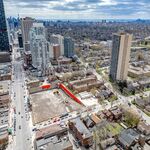High Speed Rail should have very few stations on the route to maximize the speed at which the trains can travel at. Ideally, you'd want a stop every 150-200km, so Kitchener's stop could be deemed too close. These distances are typical throughout Europe, but there are some exceptions.
Adding more and more stops, like a station in Brampton just slows down the trains to the point where the 'high speed' in high speed rail doesn't really exist.
Wait, Trois-Rivières (CMA: 151,773), but perhaps not Kitchener-Waterloo (CMA:477,160)?
Yep, there seems to be a bit too much fixation on moving trains quickly as opposed to moving people quickly.
Since any "high-speed rail" will likely have to pass through Brampton (unless the 407 rail corridor is ever built, which would actually be better suited to frieght anyway), speeds will likely be limited to whatever CN allows, there's probably no harm in stopping there, especially with LRT connections to Mississauga City Centre and BRT connections to York Region.
We're not going to have 300 km/h high-speed electrified rail to London (as great as it sounds). If the province goes ahead, it's much more likely going to be at best 125MPH (200km/h) diesel train consists, but more likely US "higher speed rail", meaning max speeds of 110MPH (175 km/h), which I think is fine and actually well suited to Toronto-Kitchener service.
In this context, Brampton makes so much sense because of the regional connections available there.
The focus really needs to be fixing the PSO in Guelph (which probably means knocking down a
few old houses on Kent Street) and upgrading the track to 110-125 MPH operation, especially between Georgetown and Kitchener on the CN/GEXR Guelph Sub (and Kitchener-London via Stratford if extended to London). It might mean a new alignment around Limehouse/Acton, but not necessarily so.
The stations should be:
Union
Pearson-Woodbine
Brampton
Guelph
Kitchener
(Stratford) - a relatively small city; it'd rely heavily on tourism and should have joint-ticketed bus or van connections to midwestern Ontario towns like Seaforth-Clinton-Goderich, St. Marys, Listowel-Hanover, etc.
London





